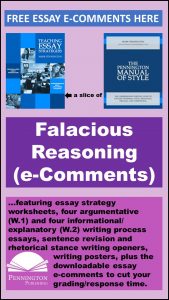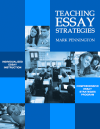 Skillful readers analyze the quality of written and spoken evidence and the writer’s reasoning and analysis of that evidence. They can identify fallacious arguments and
Skillful readers analyze the quality of written and spoken evidence and the writer’s reasoning and analysis of that evidence. They can identify fallacious arguments and
spot biases. Skillful writers know how to construct an argument with an effective line of reasoning. However, these are skills that must be taught, not just caught.
One logical method of instruction is to teach students what is good argumentative writing. Each of my Grades 4-8 and High School Teaching Grammar and Mechanics programs provide mentor texts to model exemplary language for each grammar and usage lesson focus. My TEACHING ESSAYS BUNDLE program includes mentor texts for students to master step-by-step essay strategies.
Another logical method of instruction is to teach students what is bad argumentative writing. That’s what the Errors in Reasoning does. If your students don’t understand faulty reasoning and inadequate analysis, they won’t be able to produce the clear reasoning and solid analysis we expect and hope them to learn.
Check out all 15 Errors in Reasoning. Each error includes a concise definition, example, and explanation of an error in reasoning (fallacious argument).
The Errors in Reasoning Worksheets are found in my comprehensive TEACHING ESSAYS BUNDLE program. This how-to-teach-the essay program also includes 438 insertable Essay e-Comments, including
15 Fallacious Reasoning e-comments, formatted for essay response. Set up to automatically insert into student essays in Microsoft Word and Google Docs. This video shows you how.
But wait… There’s more. Read the article and download 4 (out of the 15) of the Errors in Reasoning Worksheets at the end of this article.
1. Synonym Errors
A synonym reasoning error occurs when the writer substitutes one term for another in the argument, yet the terms are not same.
Example: The undemocratic government of Mexico had only one political party with real power. This dictatorship has been in control of Mexico since 1919.
Explanation: The writer substitutes dictatorship for undemocratic. However, not all undemocratic forms of government are the same as dictatorships.
2. Non Sequitur Errors
A non sequitur reasoning error means that the argument does not follow logically. In other words, the conclusion cannot be reached from the facts presented.
Example: If the sky is blue, and blue is the color of the ocean; then the sky must be made of ocean water.
Explanation: The conclusion that “the sky must be made of ocean water” does not follow logically from the facts presented.
3. Red Herring Errors
A red herring reasoning error means that an unconnected reference is used to distract the reader from the argument. A red herring refers to a smelly fish that was sometimes used to throw hunting dogs off the track of the fox in English foxhunts.
Example: The politician suggests that poverty remains the most important problem in the world today; however, the world has always had its share of poor people.
Explanation: The statement “the world has always had its share of poor people” attempts to distract the reader from the issue of poverty as the most important world problem.
4. Unsupported Generalization Errors
An unsupported generalization reasoning error applies specific facts to a broad generalization without justification.
Example: Bobby and Amanda have blonde hair. They both excel at sports. All blonde children excel at sports.
Explanation: The fact that specific children who have blonde hair are good athletes does not justify the broad generalization that “All blonde children excel at sports.”
5. Poisoning the Well Errors
A poisoning the well reasoning error means that an argument is weakened by a criticism in the argument itself.
Example: The president’s plan to reduce taxes in order to encourage taxpayers to spend more money to help business has been harshly criticized as “unworkable” by all leading economists.
Explanation: The president’s argument that reducing taxes will encourage taxpayers to spend more money is weakened by the comment that all leading economists have criticized the plan.
6. Cause and Effect Errors
A cause and effect reasoning error occurs when the writer assumes that something directly causes something else, but the result is actually a matter of coincidence.
Example: An irritating commercial aired after my favorite television show. I sneezed twice. Irritating commercials always make me sneeze.
Explanation: Sneezing after a commercial is a matter of coincidence. Commercials do not cause sneezing—there is no logical cause-effect connection.
7. Begging the Question Errors
A begging the question reasoning error takes place when the writer assumes something to be true, that has not been proven, in order to support the argument.
Example: No one likes the poor musicianship of country music.
Explanation: The statement assumes that country music has poor musicians to support the argument.
8. Either-Or Errors
An either-or reasoning error sets up a false choice between two ideas or issues and ignores other options.
Example: Either you support the president, or you are not a true American.
Explanation: The statement ignores other options that true Americans might choose.
9. Comparison Errors
A comparison reasoning error attempts to find similarities or differences between two unrelated ideas or issues.
Example: The price of Chinese tea has increased and so has the price of American gasoline.
Explanation: The price of tea and gas are unrelated issues and cannot be compared.
10. Questionable Authority Errors
A questionable authority reasoning error refers to a source that is not a specific expert on the idea or issue.
Examples: Experts say that the world will run out of oil in 20 years. A Harvard mathematician claims that love at first sight is impossible.
Explanation: In the first example, the expert is non-specific. In the second example, a mathematician is not an expert in matters of love.
11. Contradiction Errors
A contradiction error says the opposite of what has already been stated in the argument.
Example: Skateboarding is the safest of all individual sports. Skateboarding injuries account for more hospital visits than any other sport.
Explanation: Skateboard injuries contradict the claim that the sport is safe.
12. Inconsistency Errors
An inconsistency reasoning error refers to parts of an argument that are not in agreement.
Example: Children should be required to wear helmets while riding bicycles, but not while in-line skating.
Explanation: The arguments that children should be required to wear helmets while riding bicycles, but not while in-line skating, are not in agreement.
13. Omission Errors
An omission reasoning error means that a necessary piece of information is missing in the argument.
Example: The Folsom High School Band has the best band in the city.
Explanation: The fact that the Folsom High School Band is the only band in the city has been omitted.
14. Oversimplification Errors
An oversimplification reasoning error reduces a complicated idea or issue to something simple.
Example: Baseball is a simple game of pitching, running, hitting, and fielding.
Explanation: This oversimplification ignores the complicated components such as baseball strategy, substitutions, and statistical probability.
15. Sampling Errors
A sampling reasoning error refers to the data from which conclusions have been drawn. A sampling error may relate to an insufficient sample size or an unreliable sample group.
Example: Three out of four dentists surveyed agree that people should floss twice per day.
Explanation: Only four dentists made up the sample group—hardly enough people upon whom to base a conclusion. Also, perhaps three of the dentists are paid by dental floss companies to promote their product.
Purchase the author’s TEACHING ESSAYS BUNDLE to get 8 complete writing process essays (4 argumentative and 4 informational-explanatory) with accompanying readings, 42 sequenced writing strategy worksheets, 64 sentence revision lessons, additional remedial worksheets, writing fluency and skill lessons, posters, and editing resources. Also get the e-comments download of 438 writing comments to improve written response and student revisions.
“Great step by step worksheets that help students build or reinforce essay writing skills.”

TEACHING ESSAYS BUNDLE
Michelle Hunter
“A thoroughly comprehensive format to teach writing. Just what I needed.”
Tim Walker
Get the Errors in Reasoning Worksheets FREE Resource:

Reading, Study Skills, Writing
bias, errors in reasoning, essay, evidence, fallacious reasoning, informal fallacies, logical fallacies, Mark Pennington, reading comprehension, reasoning, Teaching Essay Strategies

